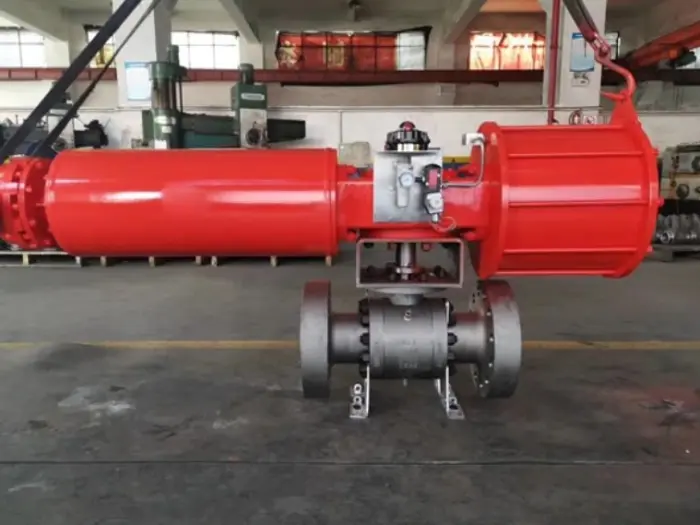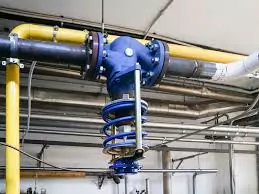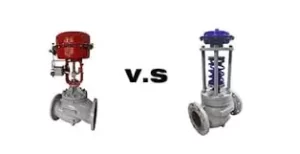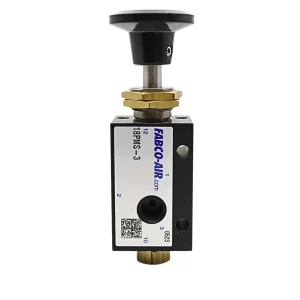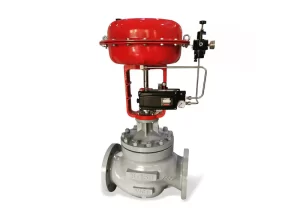A pneumatic ball valve operates by using compressed air to rotate a spherical ball with a hole through its center, controlling the flow of fluids.
This rotation aligns or blocks the passage of fluid, allowing for precise control.
Pneumatic actuators provide the necessary force to move the ball quickly and efficiently.
This type of valve is widely used in automated systems where remote or automated control is essential.
Working Principle of a Pneumatic Ball Valve
Pneumatic ball valves are designed to control the flow of fluids using a spherical ball with a central hole.
The valve’s operation is primarily driven by a pneumatic actuator, which uses compressed air to rotate the ball. Here’s a detailed breakdown of how they work:
Phase 1: Activating the Actuator
The process begins with the actuator receiving a signal to either open or close the valve. This signal can come from a manual control, a remote control system, or an automated process controller.
Phase 2: Utilizing Compressed Air
Once the signal is received, the pneumatic actuator uses compressed air to generate the necessary torque. Depending on the type of actuator, this can involve a spring-return mechanism or a double-acting mechanism.
Phase 3: Rotating the Stem and Ball
The generated torque is transmitted through the stem, which is connected to the ball inside the valve body. As the stem rotates, it turns the ball.
Phase 4: Controlling the Flow
The ball has a hole (or port) through its center. When this hole is aligned with the valve’s inlet and outlet, fluid flows through. When the ball is rotated 90 degrees, the solid part of the ball blocks the flow, stopping the fluid.
This mechanism allows for quick and efficient control of fluid flow, making pneumatic ball valves ideal for applications requiring rapid response and reliable operation.
What is the pneumatic valve method?
The pneumatic valve method refers to the use of compressed air to control the operation of valves.
Pneumatic valves include a variety of types, including ball valves, butterfly valves, and diaphragm valves, all of which rely on air pressure to actuate the valve mechanism.
The method is favored for its reliability, safety in hazardous environments, and ability to provide precise control in automated systems.
Key Aspects of the Pneumatic Valve Method
| Key Aspect | Description |
| Air Supply | A consistent supply of compressed air is essential. This air is usually delivered at pressures ranging from 60 to 120 psi. |
| Control Signals | Pneumatic valves can be controlled by manual levers, electric signals, or even sophisticated control systems that manage airflow based on process requirements. |
| Actuation Mechanism | The actuator converts the energy from compressed air into mechanical motion. This motion can be rotational, as in ball and butterfly valves, or linear, as in diaphragm and gate valves. |
How does a 2 way pneumatic valve work?
A 2-way pneumatic valve has two ports: an inlet and an outlet. The valve’s primary function is to either allow flow through these ports or to block it. Here’s how it works:
Step 1: Activating the actuator
When a control signal is sent, the pneumatic actuator is activated using compressed air.
Step 2: Opening and Rotating Mechanism
If the signal instructs the valve to open, the actuator rotates the ball so that the hole aligns with the inlet and outlet ports, allowing fluid to pass through.
Step 3: Closing the Valve
Conversely, if the signal is to close the valve, the actuator rotates the ball 90 degrees, blocking the flow path and stopping the fluid.
Step 4: Controlling the Flow
The 2-way valve can be used in both normally open (NO) and normally closed (NC) configurations, depending on the desired flow control in the system.
Types of Pneumatic Ball Valves
There are several types of pneumatic ball valves, each designed to serve specific functions in various applications:
1: Floating Ball Valve
The ball is not fixed but held in place by the valve seats. When pressure is applied, the ball floats slightly downstream to maintain a tight seal. These valves are common in low to moderate-pressure applications.
2: Trunnion Ball Valve
The ball is anchored by a trunnion, which provides additional support and allows the valve to handle higher pressures. This type of valve is often used in oil and gas pipelines.
3: V-Port Ball Valve
The ball or the seat has a V-shaped notch, allowing for better control over flow rates. These valves are ideal for applications requiring precise flow regulation.
4: Multi-Port Ball Valve
Featuring more than two ports, these valves can route fluid in multiple directions. They are useful in complex piping systems where multiple flow paths need to be managed.
5: Reduced Bore Ball Valve
The bore (hole) through the ball is smaller than the valve’s pipeline. This design reduces flow capacity and is used where full flow is not necessary.
6: Full Bore Ball Valve
The bore is the same size as the pipeline, allowing for maximum flow. These valves are used where unrestricted flow is critical.
How do I choose a pneumatic valve?
Selecting the right pneumatic valve involves considering several factors to ensure it meets the specific needs of your application:
Tip #1: Identify certain requirements
Determine the type of fluid, pressure, and temperature conditions the valve will encounter.
Tip #2: Consider the Valve’s Flow Rate
Choose a valve that can handle the required flow rate. Full-bore valves are ideal for high flow rates, while reduced-bore valves suit lower flow rates.
Tip #3: Choose a compatible valve material
Ensure the valve materials are compatible with the fluid. For corrosive environments, materials like stainless steel or special alloys might be necessary.
Tip #4: Consider the Actuation Speed
Consider how quickly the valve needs to open and close. Applications requiring rapid response may need a different actuator type.
Tip #5: Key in the Size and Space Constraints
Ensure the valve fits within the physical constraints of your system.
Tip #6: Look for Certification and Standards
Verify that the valve meets relevant industry standards and certifications for safety and performance.
Pneumatic Ball Valve Manufacturer: Gowin
Gowin, founded in 2007, is a leading valve manufacturer trusted by global industries in oil & gas, chemical, metallurgy, power, water supply, and energy.
Offering a wide range of valves, including ball, gate, globe, check, butterfly, plug, and needle valves, Gowin is renowned for delivering top-tier products and maintaining strong relationships with clients.
With ISO9001 & ISO14001 certifications and standards like API6D, TS, OHSAS45001, Fire Safety API607 & API6FA, Gowin ensures high-quality, reliable solutions for critical and everyday applications, solidifying its reputation for excellence and innovation in the industry.

